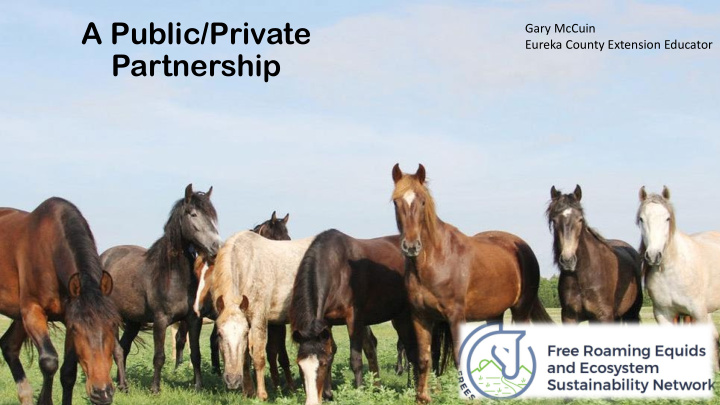



A Public/Private Gary McCuin Eureka County Extension Educator Partnership
Wild Horse and Burro Program Program goals: • Healthy wild horses and burros on healthy public rangelands • Protect health and welfare of animals and the public lands • Care for and place excess animals into good homes Map of Bureau of Land Management and Forest Service 2 wild horse and burro management areas on public lands
Overpopulation Effects • Impacts to soil, vegetation and wildlife habitat • Herd health is put at risk when overpopulation is allowed to persist. • Moving out of designated management areas, onto private land and public highways • Affecting other land users such as hunters and livestock permitees as well as the economic viability of small western communities
Herd Overpopulation 50,000 • Overpopulation at record level since 1971 Off-range • BLM nearly tripled removals in FY18 over previous years and plans for 8,000 in FY19, 88,000 though more needs to be On-range done • On-range pop exceeds AML by >60,000 animals 27,000 • Only 31 (17.5%) of all 177 8,000 herds are within AML Appropriate March 2019 FY19 Management Total Removals* On-range estimates as of March 1, 2019 Level Estimated Off-range inventory as of April, 2019 Population *Anticipated removals
High Off-Range Costs $90 $80 $80.5 million appropriated $70 in FY2019 $60 $52 million $50 for off-range holding $40 $30 More than 60% $20 of budget is for off-range $10 holding $0 2004 2005 2006 2007 2008 2009 2010 2011 2012 2013 2014 2015 2016 2017 2018 2019 WHB Appropriations Off-Range Holding Costs Note: holding costs for FY19 are preliminary
WHB P PROGRAM R RES ESET ET Phase e I I – On On R Range W WHB HB • Reduce all horse and burro populations to the low end of AML on all HMA’s • All areas outside of designated HMA’s zeroed out by complete and total removal (including all future years). • 60,000 animals transferred from rangelands to Off-Range facilities Actual Cost for long term care at current WHB Numbers 107,000 Animals x $1,040 = $111 million annually Holding cost to year 2039 (20 years)≈ $2.2 Billion The cost of rangeland degradation by WHB to society is unknown but is likely more staggering than mere holding costs estimated here
WHB P PROGRAM R RES ESET ET Phase II II – Off ff-Range e WH WHB Private Public Partnerships • Tax credits would provide funding for care of animals by private entities • Any US tax payer could provide funding through a charitable contribution • Business tax credits could be either refundable or non-refundable • Tax Credits sunset in 20+/- years with attrition of animals by natural death
Public/Private Partnership Benefits • Shifts majority of the burden from BLM (govt.) to private sector • Opens BLM off-range short term holding facilities to allow for necessary gathers of excess horses in emergency and non- emergency situations • Increases BLM’s ability to manage on-range populations • Avoids unlimited sale and euthanizing excess animals – Socially acceptable and politically feasible Inaction is a choice Resulting in unacceptable consequences
Recommend
More recommend